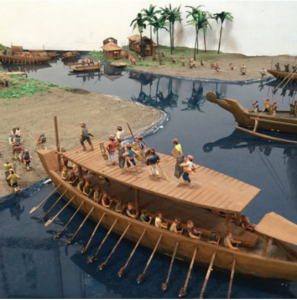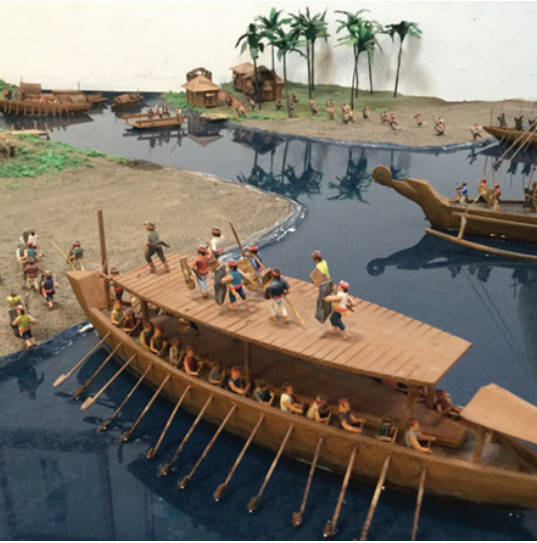
photo from: Sulu Gaden
The Salakayan Festival of Miagao (Province of Iloilo) is celebrated every first week of February to commemorate the battle in which the people of Miagao successfully repulsed Muslim raiders (referred to as Moros by the Spanish). The Festival is a colorful depiction of this event that occurred in 1754. As festivals continue on over the years, the significance of the momentous event is often lost to fast movement choreography, heart pounding sounds and artistic passions of our modern times.
A real battle, like that of Salakayan (from the root word salakay meaning to attack), is neither joyous nor artistically choreographed. It is a bloody, painful and terrifying event for the men and women of the opposing sides. During this period of Philippine colonial history, the Muslim raiders depopulated Visayan towns by as much as 50% through enslavement and battles. It was a period when the very survival of many Christian towns hanged in the balance. But, it was a two sided invasion too. The following year, the Spanish and Christianized native allies would also stage an invasion of their own against the Muslim coastal towns along the far south of Sulu Sea. It was a tit-for-tat exchange that lasted for 333 years of our colonial past. There is a dearth of information on that actual battle in Miagao. There was no record available even now how the battle was won and how long it took; how many have died; or even how many were engaged. It is even a mystery where in Miagao the actual battle took place. Neither do we know which Moro tribes we fought that day (there are 13 major Muslim tribes in Mindanao). What is known for now came through the writings of Elias N. Failagao and other historical records of the Moro Wars. Today, it is hard to imagine that period of our history. Most consider historical events as nothing more than just another day.
The Battle for Miagao, referred in Miagao as Salakayan, occurred supposedly on May 7, 1754 during a period of intense warfare between the Muslims of Mindanao who resisted conversion to Christianity and the Spanish and Christianized allies of Visayas and Luzon. Islam, prior to Spanish conquest, was a benign religion in the Visayas and Luzon, tolerant of natives practicing their own brand of religion, from animism to worship of ancestors. For this reason, Christianization of the tribes in both Visayas and Luzon was relatively easy. Muslims in Mindanao were more deeply religious and the call for jihad against Spain created a single enemy for the normally warring tribes. The date of Salakayan was recorded in Elias Failagao’s 1979 book “History of Miagao.” This book was vetted as a historical reference by the Philippine National Historical Commission. Cotta, the watchtower, was built about the same period. The third and present day Church of Miagao was not built until 40 plus years later after Salakayan. How the battle was fought remains a mystery too. Hopefully more will be known as people begin to appreciate our own local history. “Defending Cotta: Thoughts of a Comisario in the Morning of Salakayan” is written from the point of view of a fictitious comisario, the person being attacked in the salakay, who is about to face insurmountable odds
in the very front of the battle lines. The timelines are real and so are the names of major Spanish and minor officials of the period. How the actual battles were fought is a calculated guess considering how battles were fought on the 18th century and considering Miagao’s
terrain. The episodes presented took into consideration how the salakay began, how the local chieftain directed the defense of the Cotta and the whole town, what was the role of the Spanish Conquistadores and the battle that ensued from the eye of a local warrior.
In “Attack on Cotta: Thoughts of an Iranun Warrior at Sunrise on the Day of Salakayan” we will attempt to present the salakay from the point of view of an Iranun warrior – the pirate attacker. Again, the timelines are real and so are the historical figures and places mentioned. That the Muslims lost 2,000 warriors in a single battle the year before the Salakayan is in the history books. Port Holland existed briefly in Basilan. The island of Naatura Besar, the State of Terengganu (Malaysia), the Indian cities of Thoothukudi and Thiruvananthapuram are all real. (Jonathan R. Matias has a Marine Research Center in Thoothukudi). It is hoped that by writing about Salakayan from both the point of view of the attacked and the attacker, we will be able to chronicle and bring history to life by humanizing
the historical characters on both sides of the opposing forces. We hope that by writing this way, our people will begin to see that our old history is rich and not one sided. The raiders during the Battle for Miagao had their own point of view and unique cultural diversity. Those combatants on both sides of this religious war suffered, bled, and died for their beliefs.
excerpts from the writings of
Jonathan R. Matias
Sulu Garden, Miag-ao, Iloilo
www.sulugarden.com

